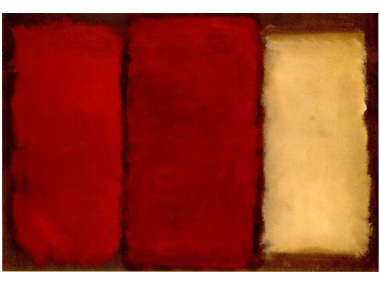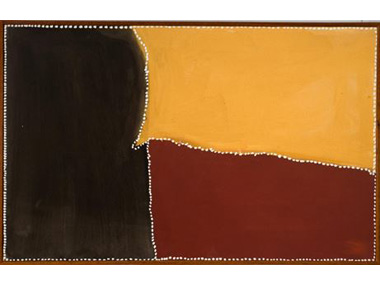Painting is the Skin of the World

Artwork from Abstraction Expressionist, Mark Rothko (b. Russia 1903 d. New York 1970) who Rover Thomas once compared his painting style to. The similarities between this and Kudditji Kngwarreye's (Emily's brother's) style are striking.
Frannie Hopkirk | 31.03.14
Author: Frannie Hopkirk
“Painting is the Skin of the World.”
Robert Motherwell
Turkey Tolson Tjupurrula said:
“When you sit down without a painting, you are lonely”.
These simple words from two giants of art speak volumes of what painting meant to them. Motherwell, a New York Abstract Expressionist from the sixties. Turkey Tolson Tjapaltjarri, a Papunya artist working in the seventies. Men, from similar times but different galaxies, both expressing the joy of being painters, the psychological power of allowing creativity to work, of living in societies conducive to creativity, safe unthreatening environments - painting whatever the odds - New York or Papunya!
The era of Abstract Expressionism has always been a favorite - sensual and pleasurable in ways that pure Pop art never was. Motherwell, Rauchenberg, Morris Louis, Rothko are exciting artists whose paintings, some of which I saw when I was in New York in 1969, continue to thrill.
Linking American and Aboriginal artists was obvious. And a bolt of lightning. That Rover Thomas and Robert Motherwell preferred the same palette of natural colours: ochre, black, white, yellow, blue, as well as the wonderful spaciousness of colour-field, brought much of it home to me.
Robert Hughes puts the words ‘Utopia’ and ‘Abstraction’ together as though they were brothers. These connections are interesting. There can surely be no connection between the name of a small Aboriginal settlement in the Australian desert with the concept of abstraction in the context of art in America, or elsewhere. Is abstract art utopian? Is Aboriginal art abstract?
But the huge success of contemporary indigenous art, as it has appeared out of Utopia, is due, in great part, to a style of ‘abstraction’ – or Abstract Expressionism, a recognizably European art form, embraced decade after decade and arguably one of the most enduring art movements since the Baroque.
The dichotomy lies in that Aboriginal art can never be classified as a ‘movement’. There is urban art, or desert art, but these are not labels. This art comes from a realm where there are no boundaries or expectations. Rules, when they exist, are subtle.
This is the realm where things cannot be accounted for mentally, but are a state of mind. This is the world of ‘feeling’ where art, like poetry, originates. The sensuality of this lies in its freedom, the lack of restraint, the existential carelessness, the magic liberty.
Morris Louis, from that era, painted in ways very like Aboriginal artists. He used a technique of dyeing the canvas, sealing it against everything but the action of colour. This produced a surface that could be both impersonal and decorative, exciting and interesting but offering nothing in particular.
As with Aboriginal art, the intended brush stroke or drawing of outline or subject, is out and nothing but colour is then applied to the canvas. Louis’s method of pleating then flooding the folds with paint, scrubbing and blotting, is similar to what we see in the works of many desert painters. You always felt in his layering of stripes, one atop the other, that he was disguising something. You wondered what was beneath the stripes – it’s stylistically catchy, and very much part of the appeal. The stripes employed by Emily Kame Kngwarreye, Minnie Pwerle and others, are similar to Morris Louis’s technique of pleating colour into organic vertical lines.
Kenneth Noland too simplified patterns, presenting them as racks of colour and nothing more. Colour, not drawing, always being the focus. Abstract Expressionism, sometimes described as ‘a pure uncluttered hedonism for the eye’ is openly decorative, anxiety-free, socially indifferent, delectable and inoffensive. This is not to say that it lacks intelligence or seriousness. This, like Aboriginal art, too, is rigorously intelligent, never a mere evocation of agreeable feelings. Walk into a large exhibition of Indigenous art and expect to be mentally and emotionally altered.
By not exploring the domain of questioning or challenging or being ambiguous. by painting instinctively, (as one should live life,) how do you fare? If the only rules are in respect of country and the keeping of secrets, then within these dictates, past those fundamentals of traditional law, you have art that is essentially anarchic. There is great power in this. The notion of ‘freedom’ was never more evident than in the art associated with Abstract Expressionism.
Rover Thomas – is a masculine ‘narrative’ painter who paints about violent and destructive events such as massacres and other serious disputes between blacks and whites. But there are no tears, no rages against injustice. His sublime colour-field pictures are coded messages of former tragedies and landscape. The only clues are in the darkness of his palette, and the deep, somber, sense of mystery and unease he imparts.
Rover Thomas once famously compared himself to Rothko. There is much discussion to be held around this endearing story. Thomas, who does possess the magnetism of Rothko, was referring to technique or style. But there was more to this statement than that.
Once when I was in a art museum in New York (Metropolitan, I think), I spent a very long time looking at Rothko (whose style was actually very similar to Kuddiji Kngwarreye, Emily's brother) - it was the kind of lost time one indulges in art galleries in foreign cities. I was mesmerized by dozens of large canvases, obviously a very significant collection. I had no idea what they meant but they worked their way into me and remain like tattoos on my brain.
Tearing myself away I went into the next room, which was filled with Rembrandts. I know I go on, but this small step from one from one gallery to another was revelatory. The Remmies (as Brett called them) were singing off the walls. I was looking at paintings I knew by heart but had never before seen in the flesh. This is the wonder and gift of the great art institutions of the world.
But the incredible thing was that the Rothkos and the Rembrandts were equal in power. This is the moment of acknowledgement of mystery and magic. If you had asked me why these two giants from opposite ends of the spectrum could equally move me, I would not know the answer.
Like falling in love. Like any of the unfathomable events in life, there is no answer.
The centuries old practice of detached, blissful, painting sessions in the desert, chanting, singing, telling stories of country and daubing colour, must have experienced a volcanic shock when the outside world arrived and the art was suddenly being paid for. When many of these artists, like Turkey Tolson or Emily Kngwarreye, were struggling with speaking English, how the hell did they deal with the pressure of hungry dealers? The numbers of ‘patrons’ virtually waiting on their doorsteps?
What has been the psychological impact of sophisticated white men, pockets stuffed with cash and plenty to say but possibly little real understanding with what they were dealing with, driving in then leaving with 4xdrives stacked with art. Monetary value, for what was hitherto used for traditional communal, sacred or ceremonial purposes, of little consequence to outsiders, was not what creativity was all about. It must have blown up a storm of dust when art was winning international prizes, being shown in Biennales and collected by famous people all over the world.
How has the influx of wealth changed the delicate social structures of outback communities like Utopia?
So many of these desert artists are elderly, with health and eye-sight problems. One can only hope they are still enjoying the painting life – chanting, singing, telling stories of country, and happily daubing colour.
Share this:
»  del.icio.us
»
del.icio.us
»  Digg it
»
Digg it
»  reddit
»
reddit
»  Google
»
Google
»  StumbleUpon
»
StumbleUpon
»  Technorati
»
Technorati
»  Facebook
Facebook
Contact Details

"Home Country" by Rover Thomas. Courtesy Ancestral Modern: Australian Aboriginal Art Exhibition, from the Kaplan & Levi Collection.

Self-portrait, Rembrandt (1606-1669)
Further Research
Artists: Emily Kame Kngwarreye | Kenneth Noland | Kuddiji Kngwarreye | Minnie Pwerle | Morris Louis | Rauchenberg | Rembrandt | Robert Motherwell | Rothko | Rover Thomas | Turkey Tolson Tjupurrula
News Tags: Abstract Expressionism | Brett Whiteley | Emily Kame Kngwarreye | Frannie Hopkirk | Kenneth Noland | Kudditji Kngwarreye | Metropolitan | Minnie Pwerle | Morris Louis | New York | Papunya | Pop art | Rauchenberg | Rembrandt | Robert Motherwell | Rothko | Rover Thomas | Turkey Tolson Tjupurrula | Utopia
News Categories: Feature
News Archive
- 11.10.17 | RETURN OF MUNGO MAN
- 10.10.17 | TARNANTHI 2017
- 11.08.17 | Natsiaas 2017
- 08.08.17 | ABORIGINAL ART ECONOMICS
- 02.08.17 | SCHOLL'S NEXT MOVE
- 20.07.17 | APY ART DOMINATES THE WYNNE
- 17.07.17 | Anangu Artist Wins $100,000 Prize
- 14.07.17 | The End of AAMU
- 13.07.17 | YOU ARE HERE
- 11.07.17 | ART ACROSS THE COUNTRY
- 11.07.17 | TARNANTHI IN OCTOBER
- 05.07.17 | TJUNGUṈUTJA - from having come together
- 02.07.17 | BENNELONG
- 27.06.17 | JIMMY CHI
- 23.06.17 | Blak Markets at Barangaroo
Advertising

